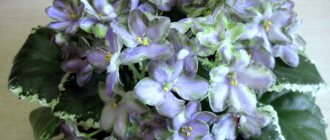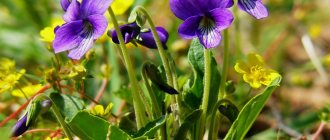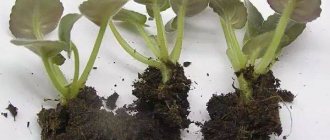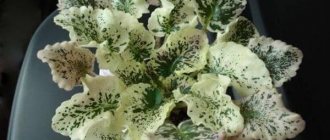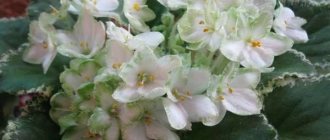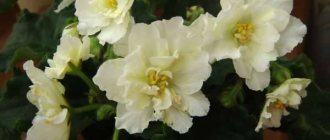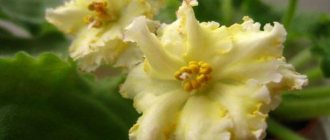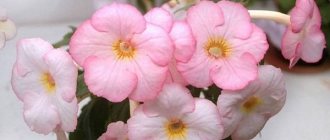In this article we will look at photos and descriptions of Rob's Hallucination and Rob's Perfect Peach violets from breeder R. Robinson.
You will find out what needs to be done to achieve beautiful bouquet flowering and how much time is needed for this?
Experienced flower growers will share their care secrets.
Such different violet flowers
Viola (garden violet) grows in open spaces, and Saintpaulia is only suitable for indoor growing, as it does not tolerate frost. The first genus belongs to the violet family, and the second to the Gesneraceae family.
Fragrant violet
An annual plant in which shoot budding occurs in the year preceding their growth. Once mature, the slender stems leave flower heads on the ground. Therefore, ripened seeds lie under the bush.
The peculiarity of this variety is that it overwinters with developed greenery. It tolerates cold well, but if the frost is too severe, it is better to cover it with spruce branches to prevent freezing. It loves moisture, but can rot as a result of prolonged stagnation of groundwater.
Violet graceful
Perennial with climbing stems. Inflorescences up to 4 cm, purple or yellowish. With the exception of the variety show Lord Nelson. This is a dark amethyst, almost black. Blooms from spring until frost.
Saintpaulia
This is a houseplant that is also called Usambara violet. It got its name from the area where it was found. Also because of the visual similarity to purple.
Home care
Saintpaulias prefer diffused lighting , but it should be enough. Good lighting will allow the plant to form full buds and the petals will be more saturated.
To grow semi-miniature varieties, it is best to use a six or seven pot.
Also, for these varieties of violets, coolness and the absence of sudden temperature changes are preferable.
Proper watering and fertilizing
Violets can be kept on wick watering. There are different lines of these varieties, but the size of the rosette very rarely exceeds the 12 centimeters specified by the breeder.
Top and bottom watering is possible, and some growers also grow on capillary mats.
Saintpaulias are unpretentious , but since the pot with the plant is not very large, and the violet blooms often, the need for fertilizing is quite high.
When growing a rosette, it is worth feeding it with compounds with a predominant amount of nitrogen. But growth stimulants must be used very carefully. Excessive concentration of this substance leads to active formation of lateral shoots, greening and lack of variegation.
During the flowering period, the rosettes are fed with phosphorus and potassium .
Lighting and air temperature
Both varieties love good light. It is best to combine natural and artificial. The plant can be placed on the windowsill, but in the evenings you should turn on the lamp.
35 W power is enough. The duration of daylight should be at least 12-14 hours . If there is a need to speed up flowering, then daylight hours are increased to 16 hours.
How does air humidity affect a plant?
Humidity levels should be within 55%. If the air is too humid, various diseases can occur, such as late blight.
If the air is too dry, the violet loses its attractiveness and the flowers become a little crooked . To increase humidity, place a bowl of water or damp moss near the outlet.
Soil composition
Violets prefer light soil that is well- drained . The nutritional value of the substrate should be average. Excessive amounts of organic matter are not always good for violets. This often leads to the disappearance of variegation, as well as the formation of side shoots.
Plant pruning and hygiene
If lateral stepsons have formed on the stem, they must be removed. This is not a trailer violet and should only have one growing point.
Methods of propagation of the variety
Plants are most often propagated by leaf cuttings. You can also use a lateral stepson or peduncle to obtain planting material.
Rob's Hallucination is prone to sports.
Rules for transplantation, plant rejuvenation
Violets are replanted once a year . The most favorable period is the beginning of autumn or the end of winter.
The violet must be shaken out of the pot and part of the old root system removed. All rotten and diseased roots are removed. Also, all cuts are processed with crushed coal.
You can remove from a third to half of the roots.
After this procedure, the violet is planted in fresh soil and a clean container.
Classification and popular varieties of indoor violets (Saintpaulia)
Saintpaulia is divided into:
- Collect those with large flowers. Almost all of them are terry, with folds. The blades and inflorescences come in different shades. Such Saintpaulias participate in exhibitions and are collected by collectors.
- Industrial, used for large-scale cultivation on special plantations. They are sold in large quantities to decorate holidays, offices, and administrative buildings. They do not require special care and bloom for a long time.
- They are full of brightly colored leaves of all shades and the presence of tassels. The first varieties had small flowers, later new hybrids with large inflorescences were bred.
Read more in the article Peaceful violet or Saintpaulia.
Depending on the type of leaves:
- girl - there is a light spot at the top at the base;
- spoon - with turned out edges.
- Spear - an elongated, pointed end;
- the boy is completely green;
Plates can also be:
- monochrome or variegated;
- heavily or sparsely covered, smooth.
- flat, with folds or depressions along the periphery;
Senopodia with inflorescences of different sizes in cm:
- semi-mini (up to 15);
- large (40-60).
- medium (20-40);
- mini (up to 6);
Classification by the number of additional petals:
- half flowers - 1-2 pieces in the center;
- Terry - there are many of them, they have different locations, they can be spherical or flat.
There is also a division according to the type of petals:
- Bell-shaped: connected at the base. Because of this feature, Saintpaulias cannot fully open the inflorescence.
- Wasp: Completely separated. Two are rolled into a tube, and three are elongated, hanging down.
- Star: equal length, spaced evenly from the center.
- Bowls: not broken, but the plant does not open them completely.
- Pansies: 2 in the top row, 3 in the bottom. And the top ones are smaller.
The size of the bush depends on the substrate: on nutritious soil mixture and low-growing Saintpaulias it grows to medium size.
There are also Saintpaulia chimeras with a clear line of contrasting color against the main background. Such varieties are in demand among collectors.
Lions Pirates Treasures
The buds are pink, framed with a strawberry tint. Covered with dirty lilac spots and dots. Blistered greens.
Melody Kimi
The leaves are embossed over the entire surface. Flowers are simple. The top two petals are blue, the rest are cut in the same shade.
Goddess of beauty
Emerald green forms a large, rooting bush. The inflorescences are bright, earthy, with an amethyst, mother-of-pearl hue.
Austin's smile
The blades form large rosettes. The flowers are star-shaped, solitary, purple-coral with a dark purple center and a crimson neckline.
EK-Admiral
The flowers are bell-shaped, cornflower blue, wavy. The leaves are cone-shaped, dark emerald. They have a creamy pink border around the circumference.
Robs Dandy Lyon
The inflorescences are large, bell-shaped. Colors in light green and beige tones. The foliage is dark malachite with bright white variegated leaves. Greenery forms rosettes.
Boo Man
Delicate bluish tint. The apical petals are pearlescent, sometimes greenish. Spoon-shaped plates, dark emerald color.
Ming Dynasty
The flowers are cup-shaped, heavily frilled, strawberry or lilac in color. The greenery is slightly variegated and wavy.
Luna Lily White
Leaves with a “quilted” texture, green in color, form a small basal bush. The inflorescences consist of semi-double panicle flowers.
Zemfira
The plates are colorful in the center. The petals are rolled into lilac tubes with frills.
Satellite
The inflorescences are amethyst-scarlet, reaching 15 cm. The greens are lettuce.
Blue Tail Fly
Blue variety. The lower petals are drooping, the upper ones are tubular. The foliage is tufted and forms clusters.
Gillian
Abundant, pearly flowers. Looks like a clove. Malachite leaves, rounded.
Robs Penny Ante
Snow-white, bell-shaped flowers. Dark azure eye in the center. The greens are slightly herbaceous.
Pink Sensation
Variegated variety with white-green leaves. The flowers are hemispherical, whitish, star-shaped. There are large, dull pink spots in the center of the flower.
Natalis Extravagant
The inflorescences are lacy, white-purple, with greenish, chocolate or pinkish edges. The leaves are malachite with lateral variegation.
Modern Talking
It belongs to the pansy. The flowers are frilly, hemispherical, white, with blue-purple-pink edges. The plates are flat, green.
Chain Reaction
The buds are large, slightly pudding-shaped, with a thin lilac line in the center. Sprinkled with specks of the same shade.
Queen Sabrina
Coral colored flowers. Each petal has thin amethyst stripes. The leaves are small, emerald green.
Music of the rain
The buds have a beige tint with a lilac border. Star-shaped, with a radius of 7 cm. The entire surface is covered with azure strokes and spots.
Chimpansy
The leaves are malachite-colored, with indentations. The flowers are a bright pudding color. There are wavy whitish lines running around the circumference. The surface is dotted with cornflower blue streaks and veins.
Currant dessert
Semicircular, lush, star-shaped flowers. They have a border of an unusual color, reminiscent of a shade of currant jam. Easy to grow.
Winter rose
The petals are blue-violet, with a barely noticeable whitish border around the perimeter. The mother bush conveys varietal characteristics well.
Baltika
Sea buckthorn with depressions, rich emerald color. The inflorescences are large, crescent-shaped, sky-purple, with a wide, fuzzy raceme of a whitish hue.
Alice Blizzard Baths
The flowers are small, pearly, with additional petals in the center. The blades are heart-shaped, light grassy in color.
Snow lace
Provides lush flowering. Fluffy, snow-white buds with a bluish spot in the center. Dull light green edging.
The bride's bouquet
The flowers are star-shaped, white, wavy at the edges. This Saintpaulia variety resembles a wedding bouquet. The petals are single-colored: there are no spots, streaks, or inclusions. Blooms profusely.
Georgia
The buds have raised folds, large, deep pink with lilac dots. There is a delicate light green border. With proper care it blooms profusely.
Marquise
Large, swollen flowers with a strawberry hue. The perianth has a lilac fringe with a thin pearlescent line. Emerald green.
Magdalene
Ball-shaped, fluffy flowers grow from lettuce rosettes. They are wavy around the perimeter. Growing close to each other, they create the impression of a huge bouquet. This variety was presented at flower exhibitions.
Lilac beauty
Rounded leaves form into a rosette. The flowers are amethyst with a lilac center and a dark border. Grows on thick stems. This variety is very easy to care for. He can also be raised by children.
Favorite daughter
The serrated blades are rounded, dark emerald on the outside and crimson on the inside. The plant lifts them up, closer to the sun. At the beginning of formation, the flowers are dark and small. Then they lighten, acquiring a lilac color with a mother-of-pearl border. Flowering is colorful and observed within 2-3 weeks.
Blue Dragon
The buds are large, azure in color. Framed by a greenish-white line. The variety is capricious; with the slightest lack of care, it can get sick and wither.
Blue Danube
Grown in Russia. Produces large, sky-colored flowers. The leaves are matte, embossed, with pointed tips. Grows quickly with intense light and regular watering.
Blue Lagoon
Large, star-shaped flowers. Azure, with a cornflower blue spot in the center and a purple border. Blooms for about 2 months. It does not require special care and can be grown even by a beginner.
lemon snow
The petals are pearlescent, with yellowish veins. The center and edges are painted in lapis lazuli color. Variegated variety: malachite plates with a snowy outline.
Villodene
The foliage is variegated: emerald with strawberry or white spots. The plates are curved along the entire perimeter. Apricot-colored flowers with a light green border.
Gift for a loved one
Decorative - green: rich herbaceous color with a whitish earthy border. The buds are blue with a purple base. Participates in flower exhibitions. However, it is quite easy to care for.
Velvet
The leaves are malachite on the outside and reddish on the inside. The petals are amethyst with a darker line in the middle.
Violetflower
The shoots are poorly developed. The leaves are heart-shaped, green, in the shade. The inflorescences are bluish-lilac.
Rosemary
With emerald jagged plates. Star shaped flowers with frills, blue flecks and strawberry accents on a white background.
Caprice
The greenery is variegated and wavy. The inflorescences are lush and white. The corolla is decorated with light green tassels.
Fire Moths
The leaves are oval, green. The corolla is fiery red or burgundy. The border is wide, pink or snow-white. The border changes shade throughout the growing season.
The magic of love
The flowers are lush, densely branched, resembling pompoms. The petals are arranged in the shape of a star. Color: beetroot. There is a neat pearlescent line along the edges.
Rose of Wind
The flowers are light purple with a strawberry pattern, which in places takes on a greenish tint.
Macho
A variety with large flowers. The petals are star-shaped, burgundy, amethyst with a whitish curved line along the periphery. The leaves are simple, ovate.
Ampelous Saintpaulias
There are ampelous types: their greenery is lush, and the stems hang over the edges of the pots. Planted in containers with loops. Such varieties have elongated and creeping stems and many side shoots.
The most popular varieties:
- Grote with voluminous leaves and purple cornflowers;
- Folin Snow with numerous small white flowers.
- Robs Hampti Doo with light green and pearl flowers;
- Ramblin Dots with white and gold leaves and lavender buds covered in a purple pattern;
- Summer Skies keychain with malachite round leaves, bluish buds;
Popular varieties of garden violet (viola)
All varieties are frost-resistant and light-loving. The most popular of them are:
Abendglut
Forms a dense shrub up to 20-25 cm high. The foliage is blue-green. The buds are cherry-shaped, pleasantly fragrant, reaching 6 cm in circumference. The lower 3 petals have bright red-brown spots. Flowering can be observed in April-May and again in the fall.
Adonis
Green with a slight herbaceous tint. Lemon-colored inflorescences (13-15 pieces) grow on a high stem 16-18 cm. Blooms in May.
Goldenkrone
Compact shrub up to 18-20 cm high. Buds are golden-canary in color. Their undersides are slightly wavy, with dark brown spots. Appears from April to June, reappearing in the last month of summer.
Gent Oregon mixed color
Grows up to 20-23 cm. Green - emerald. Inflorescences are red-yellow. The petals are wavy, the upper ones are wine-red, the lower ones are sunny with a purple pattern and a dark scarlet border. Flowering can be observed from April to August, many times in the first month of autumn.
Candidissima
A small shrub up to 20-23 cm. Blooms profusely from April to late spring. The flowers are white with a pleasant aroma.
Mars
Dense shrub with dark green leaves. The buds are dark blue, fragrant. The underside is curved, with dark amethyst, almost black spots. There are 24 flowers open at a time on a flower stem. Their flowering period: early spring, they appear again in autumn.
Jupiter
With dark leaves, up to 15-16 cm high. The upper petals are snow-white, the lower ones are purple-lilac, velvety. Blooms in the second decade of spring.
Bambini
One flower has several shades: sunny, pinkish, wine. In the center are black eyelashes.
Vittroka Terry lace
The inflorescences are light cornflower blue with a wide black stripe. Up to 8 cm in circumference.
There are many varieties of home and garden violets. Any lover of flowering plants can choose the variety to grow according to their tastes. For beginners, it is better not to choose collectible species, since caring for them requires certain skills and knowledge. It is recommended to start with dwarf or ampelous specimens. They are easier to handle and also very attractive and fragrant.
Saintpaulia Rob's Perfect Peach or Perfect Peach
The variety was registered in May 1995. Semi-miniature rosette . It can reach sizes from 12 to 18 centimeters.
The foliage is dark green with a pink underside.
The flower is a double or semi-double pansy of peach color with a slight pink tint. The tips of the petals are brown. Sometimes the edges of the flowers have green, but this appears very rarely.
Photo of Rob's Perfect Peach violet grown on a wick.
The the flowers depends on the conditions of detention. If the violet stands in the sun, the lighting is good and long, it produces richer buds, and the edges of the petals acquire a nice rich brown or bronze hue.
At first the flowers are very bright , and then gradually fade . Later, a green or lettuce border may appear.
Always produces a full head of flowers. There are a lot of buds on the peduncles, the flowers are all even, beautiful, like artificial ones.
Each of the flowers lasts for more than a month. One flowering lasts at least two months.
Grown on capillary mats.
The variety is not capricious and is a pleasure to grow. The rosette is a little large, but very dense and neat. The buds do not bloom for a very long time. Initially the color is either peach or apricot. Then it brightens a little.
It can be grown on a wick, then the rosette will be larger. Doesn't go into sports.
Features of flowering, growth and reproduction
The plant develops quite quickly, the first flowering can occur even at the age of eight to ten months . With each subsequent time, the bouquet becomes more and more magnificent.
Doesn't like heat, it's best to keep it cool. It is under this condition that you will be able to see a light green tint on the petals. Peduncles are low, dark, strong, well branched. Each of them has five or six buds.
It blooms for a long time , one bud lasts at least four weeks.
Reviews about violet
Ekaterina, Ryazan : “Very delicate variety, small rosette, always blooms in a bouquet. Leaf adjacent to leaf. The wick does not grow larger than 12 centimeters, despite the fact that some sources indicate a size of 18 cm.”
Angelina, Tomsk : “I replanted this variety many times, and it disappointed me. I couldn't wait for the green border. Also, judging by the reviews, it blooms profusely, but my rosette produced very few flowers. Perhaps I came across the wrong line.”
